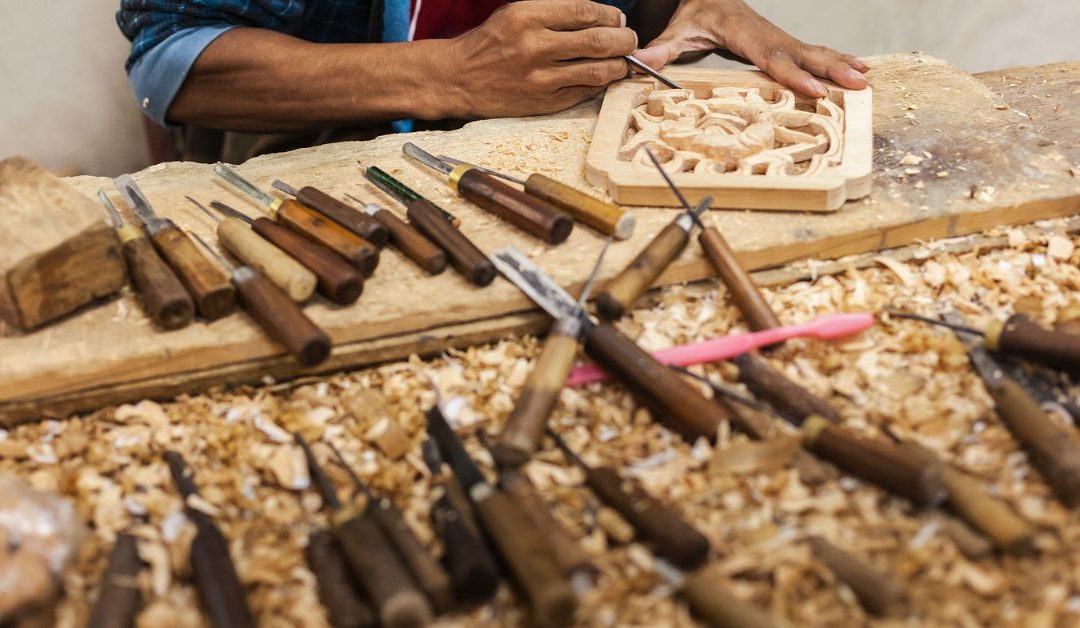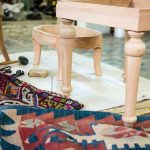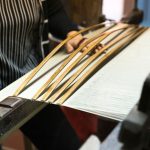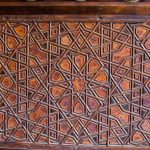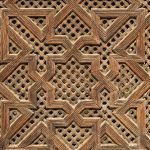Moroccans has cherished marquetry as an art form since ancient times. They are great at creating intricate designs and vibrant colors through Moroccan woodworking. Using various types of wood, metals, and other materials, they craft beautiful and practical pieces.
Marquetry is a special way to make furniture and buildings look fancy. It involves choosing and putting pretty layers of wood on their surfaces. Moroccans have been using this method for many centuries as part of their traditional craftsmanship.
Today, skilled craftsmen still use new tools and clever techniques to keep practicing this special skill. They create exquisite pieces by incorporating exotic woods from around the world. Let’s explore some examples to better understand how these remarkable works turn into reality.
History Of Moroccan Woodworking
Moroccan woodworking has amazed many with its beautiful and detailed designs. It originated from the Berber and Arab cultures that settled in Morocco long ago, creating a special mix of cultural influences.
Moroccan craftsmen use special woods like ebony, ivory, palmwood, and cedar to make their beautiful woodwork. They select these materials for their looks and artistic vision.
Creating marquetry pieces requires great skill and precision. Craftsmen cut small sections of veneer from different woods or materials into geometric shapes. Then, they arrange these shapes together to make intricate patterns on furniture surfaces. These patterns give depth and texture to ordinary objects.
Marquetry has become more and more popular because it is beautiful, long-lasting, and versatile. We can use it to make functional furniture or decorate our walls and tables, adding a unique touch to our homes.
Moroccan woodworking has something for everyone. If you like old-fashioned designs from long ago or new and unique creations made by today’s artisans, you can find amazing things all over Morocco.
With so many amazing examples of this timeless craft, it’s no wonder people want to learn more about how these pieces turned into reality. That’s why it’s interesting to explore the materials used in marquetry, both traditional and modern.
Traditional And Modern Materials Used In Marquetry
It has long been a theory that Moroccan woodworking is an art form, particularly when it comes to the craft of marquetry. This notion is visible in the vibrant colors and intricate designs found throughout the country’s history.
In Moroccan marquetry, craftsmen use two types of materials: natural and synthetic. Moroccan marquetry uses two types of materials: natural and synthetic. People use natural materials like wood from trees such as rosewood or ebony, and they have been using them for a long time. Synthetic materials are more used now because they are cheaper and last longer.
These materials have a vital role in creating beautiful works of art that people will cherish for generations. They allow for diverse patterns and capture the vibrant essence of Moroccan culture.
Natural woods offer a range of colors, from deep browns to rich reds, adding stunning visuals to each piece.
Synthetic materials can make the design feel different and more exciting without making it worse or hurting nature.
Types Of Marquetry
In Moroccan woodworking, marquetry is a special art form that makes things look beautiful. In Moroccan woodworking, marquetry is a cool way to make things look awesome. They pick different types of wood, cut them into thin strips, and then fit them together like a puzzle to make cool designs. The following table shows some of the most popular forms of marquetry:
| Type | Description |
| Inlay Marquetry | This type incorporates small pieces of wood cut in intricate shapes placed flush with the surface. These pieces are usually symmetrical and contrast with the surrounding wood grain. |
| Intarsia Marquetry | Marquetry is like making picture puzzles with wood. They use big pieces of wood in different colors or textures to show landscapes, animals, or other cool things on furniture. |
| Parquetry Marquetry | Parquets are patterns you can find on floors. They use shapes like stars or diamonds that repeat and make fancy designs. |
Each type has its own unique properties when it comes to creating visual interest and flare. With these techniques and materials at hand, skilled craftsmen have been able to produce works that stand out from their peers. Knowing which type best suits your project is key to making top-quality results. Now, let’s learn about the tools and techniques used in Moroccan woodworking when it comes to marquetry.
Tools And Techniques
Families in Morocco have passed down the skill of marquetry in woodworking from one generation to the next. It requires an eye for detail and the right tools, techniques, and materials to create intricate works of art that can last for centuries. In Moroccan woodworking, there are so many cool designs and patterns to explore. If you’re into woodworking, the art of marquetry in Morocco is super cool! Whether you like traditional styles or want to make something unique, you’ll find awesome stuff to create as an artist. It’s like a treasure hunt for creativity!
When it comes to tool selection and cutting techniques, there are some key points to keep in mind:
- Tool Selection
- Chisels: specialized chisels with different blade angles depending on the type of material cut.
- Specialized saws: fine-toothed Japanese or fret saws designed for detailed work like marquetry.
- Rasps: used as filing tools to shape small pieces into desired shapes before assembly.
- Cutting Techniques
- Hand Tools: Use hand tools such as chisels, knives, gouges, and rasps when working with more delicate woods such as rosewood or ebony.
- Machine tools are like super-powered machines that make woodworking easier and faster. For example, scroll saws and router jigs are tools that help cut wood with great precision and accuracy.
- You can use hacksaw blades or jigsaw blades for thicker stock, but they may not give you precise cuts because you have less control over them.
Choosing the right tools and knowing how to use them is super important when making artwork. It helps you create something beautiful and well-made. So, remember to pick the right tools and learn how to use them to make your artwork amazing! It ensures that your work looks finished and well-crafted. With this knowledge, you can achieve stunning results in Moroccan marquetry.
People all over the world admire Moroccan marquetry because it masters the art of decorative woodwork like no other. Armed with these tips, your next design project awaits you – unlocking geometric patterns never seen before!
Geometric Patterns
Geometric patterns are an integral part of Moroccan woodworking and marquetry. These intricate designs feature a wide variety of shapes, colors, and textures that combine to create stunning works of art. These patterns represent important symbols for the creators. Triangles are important in Islamic tradition because they symbolize the Holy Trinity. Yet, squares represent safety and protection.
Creating these intricate geometric patterns requires great precision and patience. Skilled artisans use small pieces of wood, metals, or veneers to build each piece by hand. This creates stunning works of art with special meanings. These masterpieces showcase both technical skill and elegant beauty.
People in Morocco use marquetry to make furniture and other things look beautiful and useful. You can add marquetry to your homes and workplaces to make them special and meaningful. Marquetry is a cool way to make things look awesome by combining old techniques with new ideas. It can make any place look cool and tell stories through pictures.
Next, let’s explore the world of decorative inlays, another technique used in Moroccan woodworking.
Decorative Inlays
Marquetry in Moroccan woodworking is a craft with deep cultural significance.
Skilled artisans must learn about different types and shapes of marquetry, such as decorative inlays.
Decorative inlays are like tiny puzzle pieces made from different materials put into carved wood surfaces. They make things look nice and protect delicate objects.
In the past, Moroccan artisans used bright colors and patterns inspired by nature or shapes for decorative inlays. It took a lot of patience and hard work to make these detailed designs.
Today, modern woodworkers still use these techniques, but with new materials and more creativity.
Decorative inlays are important in showcasing the talent and adding life to plain surfaces. Each design allows for creativity and appreciation of this tradition. We will now discuss how color and finishes enhance the beauty of ornamental marquetry pieces.
Color And Finishes
Having discussed the decorative inlays of marquetry and Moroccan woodworking, it is now time to move on to color and finishes.
Pigment selection plays an integral role when creating a beautiful piece of art with marquetry. Color choices vary from warm earth tones such as burnt umber or ochre to vibrant blues and greens like sapphire or emerald. Choose colors that complement each other and bring out the beauty of the craftsmanship.
When it comes to finishing techniques, there are several options available depending on what type of look you want for your workpiece. Wax finish gives a shiny look. Oil varnish protects against dirt and moisture while keeping the texture of the wood. You can also use lacquer to make it strong, shellac to add pretty colors, or polyurethane to protect it from scratches.
Choosing the right pigments and finishes make wooden art pieces stand out. Moroccan woodworkers are good at what they do. They use old and new ways to make awesome things. Even complicated designs turn out amazing in their hands.
Now that we know how to pick the right colors and finishes, let’s talk about making fancy and detailed pieces that would impress even a king or queen.
Intricate Designs
For many years, artisans have been doing marquetry and Moroccan woodworking. They keep getting better at their craft and finding new ways to use it. They create intricate designs using alternative materials like bone, metal, and horn to make stunning images.
Here’s how it works:
- Artisans begin by selecting a piece of solid wood veneer to serve as the base material for their design.
- Then, they cut small pieces from different types of wood into shapes or patterns. The shapes can be simple or complex, depending on what they want to create.
- Artisans glue these small pieces onto the wood veneer to create intricate mosaic-like designs. These designs add depth and texture to the surface.
Modern marquetry is often used for decorative purposes such as cabinets, furniture, doors and walls – even jewelry! It’s also popular among interior designers who use it to create unique accents in homes or offices. The many options and its fancy look make it a great choice when you want something unique.
Now that we know this, let’s start making the perfect piece by choosing the right colors and patterns.
Creating The Perfect Piece
Creating a perfect piece in Moroccan woodworking takes time and dedication. It requires attention to detail and skilled craftsmanship.
Cutting the wooden veneer with chisels, planes, and heated hand saws is important. This ensures that the images or shapes in the design fit together without gaps.
The end result can be furniture, wall paneling, or doorways with beautiful designs. Traditional methods passed down through generations keep this art alive in modern spaces.
Each finished work is unique because of the natural variations in the materials. Moroccan woodworking turns everyday objects into true works of art that will nurture for years to come.
Where To Find Authentic Moroccan Woodworking
It’s fascinating to discover unique pieces that capture the beauty and history of this craft. From intricate marquetry to hand-carved wooden boxes, these creations can add a special touch to your home décor. But where can you find them?
Let me tell you: it’s important to shop and support skilled artisans in Morocco. If you want to find authentic Moroccan woodworking, there are some things you need to know
Here are my top four tips:
- Look out for certifications like Fair Trade USA or UNESCO that ensure ethical sourcing practices.
- Research suppliers to make sure they treat their employees and pay them well.
- Shop around and compare prices between different websites – good deals don’t always mean good quality!
- Try asking family members or friends who have visited Morocco; they might be able to point you in the right direction.
If you want to find beautiful Moroccan woodworking art, remember these tips to make sure it’s authentic. It’s important to look for something special and support the skilled artisans in Morocco. Authenticity matters when it comes to finding the perfect piece!
Frequent-Asked Questions
How Long Does It Take To Complete A Piece Of Moroccan Woodworking?
It takes an experienced woodworker between four and six weeks to complete a piece of Moroccan woodworking.
The skill level, tools needed, and complexity of the project all play a role in determining its length.
Crafting a fine piece of marquetry requires attention to detail as well as specialized tools such as chisels, saws, hammers, and knives.
With experience and practice, but, it’s possible to create beautiful pieces that can last for generations.
What Is The Cost Of Purchasing A Piece Of Moroccan Woodworking?
Purchasing a piece of Moroccan woodworking can be an affordable and unique investment for the home.
Depending on the size, style, and custom designs desired in one’s piece, prices range from expensive to quite costly.
If you want more choices, you can search online to compare prices and quality for Moroccan marquetry art. It’s a good way to find the best option for you!
Whether seeking an intricate design or something simpler and classic, consumers are sure to find a great deal with a little research.
Is It Difficult To Learn The Art Of Marquetry?
Yes, learning the art of marquetry can be challenging. It requires a level of skill and precision to select colors and sanding techniques that will bring out the beauty in each piece.
If you practice and work hard, you can learn how to do marquetry projects with wood like the ones in Moroccan woodworking. Anyone can do it with dedication!
This type of craftsmanship takes time and patience but is worth it when completed!
What Is The Best Type Of Wood To Use For Marquetry?
Creating a masterpiece in marquetry is an art form that requires careful consideration when it comes to wood selection.
Color palettes, pattern selection, and type of wood can all affect the look and feel of your final product.
If you want to make traditional Moroccan-style marquetry, the best woods to use are cedar, olivewood, or ebony. They have special qualities and beautiful colors that will make your project impressive!
With so many options available, finding the perfect piece of wood for your next Marquetry masterpiece got a lot easier!
Are There Any Special Skills Required To Create Intricate Designs In Marquetry?
Creating intricate designs in marquetry requires a special set of skills and tools.
When artisans work, they use special tools like sharp chisels, small knives, saws, and blades to cut patterns into wood. These tools are important for creating detailed and fancy designs.
Some advanced techniques involve using a lathe or engraving tool to further refine shapes.
Craftsmen use special glues to stick different pieces of wood together in marquetry. They also use special finishes to make the design look even more beautiful.
It takes practice and patience to master these techniques but with time anyone can learn how to create beautiful works of art in marquetry.
Creating a beautiful work of Moroccan woodworking is an art. It takes time, skill, and dedication to create something magical.
With practice and patience, anyone can learn marquetry techniques. It starts with choosing the right wood and then creating detailed patterns with careful precision.
The result can be breathtaking – each piece unique in its way – providing both visual pleasure and lasting satisfaction.
I am happy as I use my brush to paint a delicate pattern because this little act of making something beautiful will bring joy to someone for a long time.

